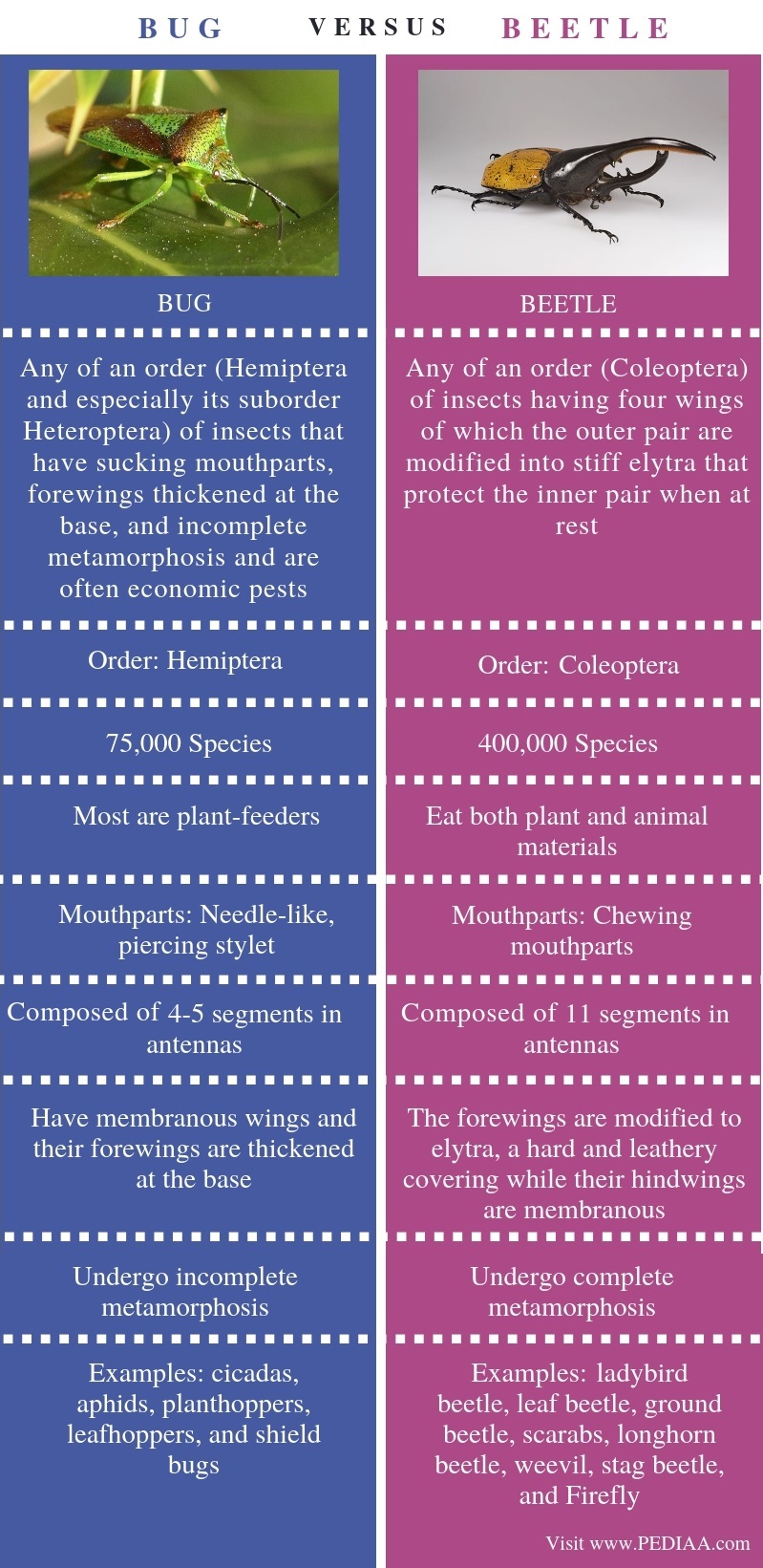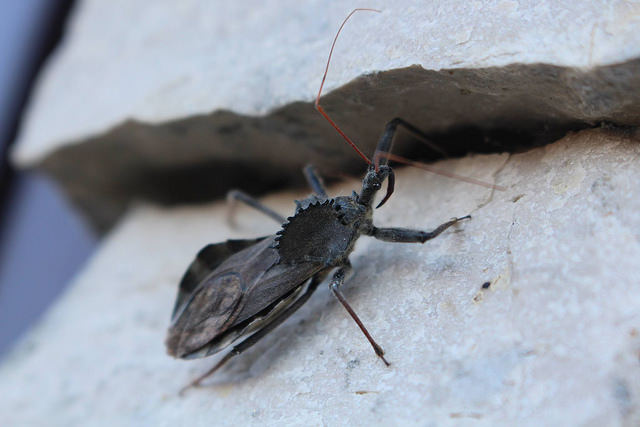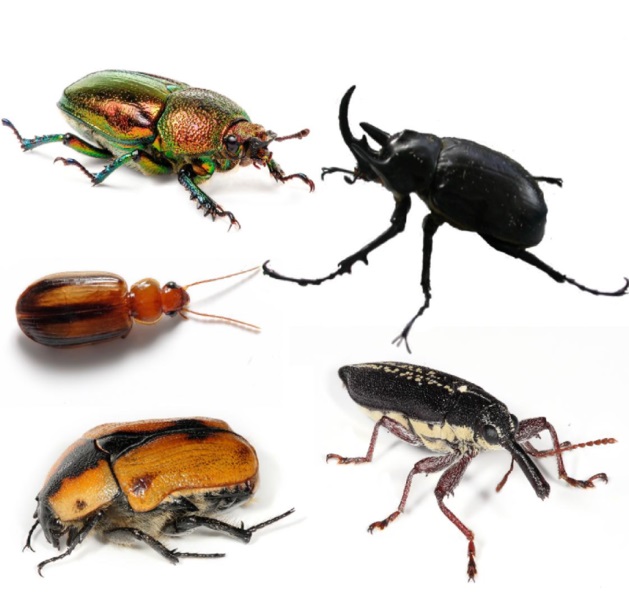в чем разница между bug и beetle
В чем разница между bug и beetle
Во-первых, в обоих случаях это – типичная для английского языка ситуация, когда для примерно одного и того же понятия есть слова германского (саксонского) и франзузского (романского) происхождения. Классический пример: ‘начинать’ – ‘begin’ и ‘commence’. Как правило германское слово бывает более «разговорным» и часто более универсальным, а французское – более формальным и «книжным».
Теперь более конкретно.
‘Mistake’ в роли глагола – буквально: ‘взять неправильно’. Т.е., нужен кто-то, кто «берет», т.е., ошибающийся субъект.
‘Error’ – это ошибка вообще. Скажем, в компьтерном коде может быть только ‘error’ – из-за ‘mistake’ программиста.
‘Fashion’: очень широко употребляемое слово, означающее «стиль», «манера» – не обязательно непременно в приложении к моде в узком смысле слова и не обязательно в позитивном смысле. Например, ‘I didn’t like the fashion you behaved’ – ‘мне не понравилось, как вы себя ведете’.
Применительно к собственно моде тоже может употребляться в самом широком смысле, например, ‘fashion industry’ – «модное дело», «индустрия моды».
‘Vogue’ – слово очень узкого смысла, часто ощущаемое в английском как иностранное заимствование (типа как, например, в русском мы ощущаем слово «гламур») и очень редко используемое в переносном смысле – применительно не к моде в одежде и стиле жизни.
Сообщение изменено (17-04-06 16:06)
Bug – в разговорном языке значит примерно «букашка», в зоологии – «клоп». В компьютерном сленге: ошибка в составлении программного кода и т.п., в шпионском деле: «жучок» для прослушки и т.п.
Beetle – значит «жук» и в просторечии, и в зоологии; а в разговорном языке еще может значить «таракан» (зоологический термин для таракана ‘cockroach’ слишком громоздок для просторечия).
Beatle – Битл (один из четверки Леннон, Маккартни, Харрисон, Старр). Слово образовано из комбинации-созвучия слов ‘beetle’ и ‘beat’ (бить, ударять), а также связанного с ним слова ‘beatnik’ («битник»).
Сообщение изменено (17-04-06 14:56)
> Beetle – значит «жук» и в просторечии, и в зоологии; а в
> разговорном языке еще может значить «таракан» (зоологический
> термин для таракана ‘cockroach’ слишком громоздок для
> просторечия).
Я встречал и у американцев, и у британцев. В особенности, «черный таракан» в быту зовется ‘black beetle’, что привычно сокращается до просто ‘beetle’. Легко по Гуглу поискать примеры.
В чем разница между bug и beetle
A beetle can be a considered a bug. Bug is just the general term/category for all insects and beetle is the specific name of the insect.
Символ показывает уровень знания интересующего вас языка и вашу подготовку. Выбирая ваш уровень знания языка, вы говорите пользователям как им нужно писать, чтобы вы могли их понять.
Мне трудно понимать даже короткие ответы на данном языке.
Могу задавать простые вопросы и понимаю простые ответы.
Могу формулировать все виды общих вопросов. Понимаю ответы средней длины и сложности.
Понимаю ответы любой длины и сложности.


Решайте свои проблемы проще в приложении!

What is the Difference Between a Bug and a Beetle
The main difference between a bug and a beetle is that a bug belongs to the order Hemiptera whereas a beetle belongs to the order Coleoptera. Furthermore, bugs are mostly plant-feeders that take a liquid diet while beetles eat a wide range of plant and animal materials. Therefore, bugs have needle-like mouthparts while beetles have chewing mouthparts. Moreover, the wings of bugs are either membranous or partially-thickened while the forewings of beetles serve as a hard, leathery covering called elytra and the hindwings are membranous.
Bug and beetle are two groups of insects that belong to two different orders. Around 75000 species of bugs and 400000 species of beetles have been identified so far.
Key Areas Covered
1. Bug
– Definition, Characteristics, Behavior
2. Beetle
– Definition, Characteristics, Behavior
3. What are the Similarities Between Bug and Beetle
– Outline of Common Features
4. What is the Difference Between a Bug and a Beetle
– Comparison of Key Differences
Key Terms
Beetle, Bug, Diet, Forewings, Lifecycle, Metamorphosis, Mouthparts, Order
Bug – Definition, Characteristics, Behavior
Bugs are a group of insects classified under the order Hemiptera. The size of bugs varies from 1 mm- 15 cm. One of the main features of bugs is the presence of sucking mouthparts. However, only heteropterans are considered as ‘True bugs’. The sucking and the piercing mouthparts allow bugs to extract plant sap and nectar. Therefore, most bugs are plant feeders. But, some of them are parasitic and others are predators that prey on other insects or small invertebrates.
Figure 1: Wheel Bug
Furthermore, both wings of the bugs are membranous. However, their forewings are thick at the base of the wing. Also, another significant feature of bugs is their life cycle. They undergo incomplete metamorphosis. That means; the juveniles of bugs are small and morphologically similar to the adult.
Beetle – Definition, Characteristics, Behavior
Beetles are another group of insects classified under the order Coleoptera. More importantly, they are the largest order, containing 40% of the all described insects and 25% of all animal forms. Around 400000 species of beetles have been identified so far. Also, weevils are the largest family of beetles. One of the significant anatomical features of beetles is the presence of chewing mouthparts. Therefore, most plant-feeding beetles damage crops while animal-feeding beetles eat aphids, scale insects, thrips, etc.
Figure 2: Beetles
Moreover, the forewings of beetles are modified structures called elytra, which are hard leathery structures, covering the hindwings at rest. However, their hindwings are membranous. Moreover, beetles undergo complete metamorphosis. Therefore, the larval stage of beetles is called grubs due to their hardened head, pupating into the adult stage.
Similarities Between Bug and Beetle
Difference Between a Bug and a Beetle
Definition
A bug refers to any of an order (Hemiptera and especially its suborder Heteroptera) of insects (such as an assassin bug or chinch bug) that have sucking mouthparts, forewings thickened at the base, and incomplete metamorphosis and are often economic pests while a beetle refers to any of an order (Coleoptera) of insects having four wings of which the outer pair are modified into stiff elytra that protect the inner pair when at rest. Thus, this explains the fundamental difference between a bug and a beetle.
Order
The main difference between a bug and a beetle is that a bug belongs to the order Hemiptera while a beetle belongs to the order Coleoptera.
Number of Species
Around 75000 species of bugs have been identified so far while around 400000 species of beetles have been identified.
Most bugs are plant-feeders while beetles eat both plant and animal materials. Hence, this is another difference between a bug and a beetle.
Mouthparts
Also, a notable difference between a bug and a beetle is their mouthparts. Bugs have a needle-like, piercing stylet while beetles have chewing mouthparts.
Antennas
Furthermore, the antennas of bugs are composed of 4-5 segments while the antennas of beetles are composed of around 11 segments.
Wings
Moreover, bugs have membranous wings and their forewings are thickened at the base while the forewings of beetles are modified to elytra, a hard and leathery covering while their hindwings are membranous.
Lifecycle
Besides, one other difference between a bug and a beetle is that while bugs undergo incomplete metamorphosis, beetles undergo complete metamorphosis.
Examples
Some examples of bugs are cicadas, aphids, planthoppers, leafhoppers, and shield bugs while some examples of beetles are ladybird beetle, leaf beetle, ground beetle, scarabs, longhorn beetle, weevil, stag beetle, and Firefly.
Conclusion
Bugs are insects belonging to the order Hemiptera. Most of them are plant-feeders with needle-like mouthparts. Generally, their wings are membranous, but the base of the forewing can be thick. In comparison, beetles are another order of insects classified under the order Coleoptera. They eat both plant and animal materials. Hence, they have chewing mouthparts. The forewings of beetles are hard and leathery. Therefore, the main difference between a bug and a beetle is their anatomical features and feeding behavior.
References:
1. “Hemiptera: Bugs, Aphids and Cicadas.” CSIRO, Available Here.
2. “Coleoptera: Beetles and Weevils.” CSIRO, Available Here
Image Courtesy:
1. “Wheel Bug in Missouri” By USFWS Midwest Region (CC BY 2.0) via Flickr
2. “Coleoptera collage” By Bugboy52.40 – Own work (from User:Fir0002 images) (CC BY-SA 3.0) via Commons Wikimedia
About the Author: Lakna
Lakna, a graduate in Molecular Biology & Biochemistry, is a Molecular Biologist and has a broad and keen interest in the discovery of nature related things
Beetles vs. Bugs
Beetles and bugs are types of insects that are classified into two different orders. There are 400.000 species of beetles that are members of the order Coleoptera, and around 75.000 species of bugs that belong to the order Hemiptera. Beetles and bugs can be found all over the world. They inhabit both terrestrial and aquatic habitats. Many species of beetles and bugs are classified as agricultural pests. Beetles and bugs are not close relatives and thanks to numerous unique features, each group of insects can be easily identified:
Beetles have hard and leathery forewings called elytra and long membranous hind wings hidden below. Hind wings are visible only when beetles are flying. Forewings of bugs, called hemelytra, are made of two dissimilar halves. They are hard at the base and membranous at the tip. Hind wings of bugs are also membranous and shorter than the forewings.
Beetles have wider geographical distribution and ability to survive in various habitats (except in the polar regions) because of their hard forewings which protect body like a shell.
Bugs have antennas made of 4 to 5 segments, while beetles have antennas made of usually 11 segments.
Bugs have needle-like mouth apparatus designed for extraction of juices (sap or nectar) from the plants. Some bugs feed on the liquids obtained from the animal tissues. Beetles have hard, tooth-like mouthparts designed for grasping, cutting, chewing and biting. Their diet is based on various plants and animals.
Most beetles are able to fly. Ground beetles and beetles that inhabit caves and deserts have lost their ability to fly. They move by walking. Aquatic beetles are excellent divers. Bugs, on the other hand, can fly, walk, jump, glide over the surface of the water or even swim, depending on the species and type of habitat. Some bugs do not move at all. They spend their entire life attached to the host plant.
Beetles undergo 4 developmental stages in their life: egg, larva, pupa and adult insect (complete metamorphosis). Larva, also known as grab, has hardened head and voracious appetite. It quickly grows in size. Pupa is dormant stage and it ends with fully developed adult beetle. Unlike them, bugs have incomplete metamorphosis. Newly hatched bugs are called nymphs and they look like miniature version of adult insects. They develop wings and attain adult size after several instars (periods in between the molting).
Association with Humans
344 species of beetles and large bugs such as cicadas are consumed as delicacy around the world. Beetles such as ladybugs and ground beetles eliminate pests from the gardens and fields. Dung beetles play important role in nutrient cycling and in enrichment of soil with minerals.
Обсуждение:bug
синонимы:beetle [ править ]
Я правильно понимаю, что про этот синоним есть вопрос?
Как этот вопрос формулируется? —DenisYurkin 09:38, 12 мая 2007 (UTC) [ ответить ]
В каком-то древнем англо-русском или русско-английском словаре слово «жук» перевели «bug» (и наооборот). С тех пор прошло сто лет, уже во все словари добавили правильный перевод (beetle), но ошибочный перевод кочует из словаря в словарь. Естественно, ни один составитель словаря не придумывает его с нуля, он лишь расширяет или сжимает чей-то старый словарь.
Вот, к примеру, статья из словаря Collins: bug I [bʌg] n 1) any insect of the order Hemiptera, esp any of the suborder Heteroptera, having piercing and sucking mouthparts specialized as a beak (rostrum) See also assassin bug, bedbug, chinch bug 2) chiefly US and Canadian any insect, such as the June bug or the Croton bug 3) informal a) a microorganism, esp a bacterium, that produces disease b) a disease, esp a stomach infection, caused by a microorganism 4) informal an obsessive idea, hobby, etc.; craze (esp in the phrases get the bug, be bitten by the bug, the bug bites, etc.) 5) informal a person having such a craze; enthusiast 6) (often plural) informal an error or fault, as in a machine or system, esp in a computer or computer program 7) informal a concealed microphone used for recording conversations, as in spying 8) US (in poker) a joker used as an ace or wild card to complete a straight or flush vb bugs, bugging, bugged informal 9) (tr) to irritate; bother 10) (tr) to conceal a microphone in (a room, etc.) 11) (intr) US (of eyes) to protrude • See also bug out Etymology: C16 of uncertain origin; perhaps related to Old English budda beetle II [bʌg] n obsolete an evil spirit or spectre; hobgoblin Etymology: C14 bugge, perhaps from Middle Welsh bwg ghost. See also BUGBEAR, BUGABOO III [bʌg] vb a past tense and past participle of big II
Как видно, слово bug означает: 1) клоп 2) букашка 3) микроб и так далее.










